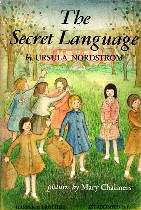 Ursula Nordstrom •
Ursula Nordstrom •
The Secret Language •
Eight-year-old Victoria North, separated from her mother for the first time, is miserably lonely when she is sent to boarding school. But in an attraction of opposites, timid Victoria finds a friend in Martha Sherman, the school’s most rebellious student.
There are no earthshaking, climactic events here. Rather, Nordstrom develops the twin themes of belonging and secrecy—two powerful motivators for children of this age—through quiet, everyday occurrences: the departure of a classmate, the loss of a tooth, the choice of a Halloween costume.
Miraculously, the girls seem to grow before your eyes. Victoria’s homesickness recedes; Martha’s defenses soften. An unpleasant housemother is replaced by a kind one. Plans for a midnight feast, that boarding school staple, go badly awry, but the hut the girls build in the woods turns out to be a marvelous retreat. And the private language Martha teaches Victoria sets the pair apart from other students, for better or worse.
Also worth noting: Victoria experiences numbers as having particular colors and genders—a trait we now call synesthesia.
Although The Secret Language is the only book to carry her name as author, Ursula Nordstrom left an indelible mark on children’s literature. During her 23-year tenure as juvenile editor for Harper & Row, she was responsible for bringing to print such modern classics as Charlotte’s Web, Where the Wild Things Are, and Harriet the Spy. The Secret Language, in addition to being a thoughtful and well-told story, gives us a glimpse of the writer inside the gifted editor.






Your email address will not be published.